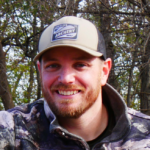How do you know where bedding areas are? What do they look like?
This is going to vary from location to location, but there are a few things that usually hold true regardless of where you're at. First, bedding areas tend to be thicker cover - if it's available. Deer want to feel protected while they are laying down. For us here in the Midwest we often find deer bedding in raspberry thickets, near blown down trees, in tall native grass stands, swamp grass, or even in standing crop fields. Second, bedding areas tend to be on higher ground in places where there is a good amount of elevation change. Deer feel safer holding the high ground where the wind is more consistent and they can see danger approaching.
A great time to scout for bedding areas is during the late winter or early spring when snow is still on the ground. Beds are easiest to see at this time, and with the leaves being off the trees you can get a better idea of what the surrounding terrain features look like to determine if and why a deer may be bedding there.
One last thing to mention is that bucks tend to bed in different areas than does, so not all bedding areas are created equal. In my experience, big bucks tend to be loners and will isolate themselves in out-of-the-way areas that aren't always near other deer. Look for them in small pockets of timber, small islands in a marsh, or other areas that get very little human pressure and don't hold high numbers of deer.

